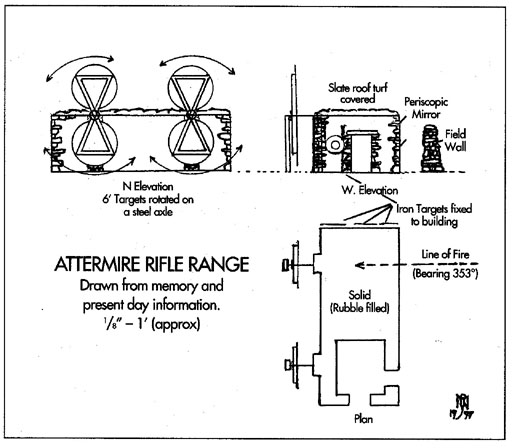| JOURNAL 1998 |
| North Craven Heritage Trust |
The Volunteers
In May 1859 relations with France became strained to the point where the Secretary of State for war permitted county lieutenants to raise volunteer rifle corps. A meeting was called on 6th June 1854 at the Court House in Settle; Walter Morrison of Malham Tarn and John Birkbeck of Anley were joint secretaries and there were thirty volunteers signed up. Each was asked to pay £2-1-0 for his own grey tunic uniform and £3-8-0 for a rifle and bayonet. The rifle was a Short Enfield muzzle loader; the breech loader did not come in until 1876. Drills were held initially in the meeting room of the Joiners Arms, now Commercial Yard in Duke Street, Settle, but by 1864 Mr Morrison had provided the drill hall at the foot of Castlebergh. From early days Settle Volunteers won fame for shooting. In matches held between Skipton, Ingleton and Settle at Malham Tarn, the Morrison silver bugle came back to Settle time and time again. The Attermire range was set up in 1860 by which time there were sixty volunteers. In 1862 Settle took the top three places when shooting against the rest of Yorkshire at York. The grey uniform had changed to scarlet but when the unit transferred to the TA in 1908 khaki was introduced. This transfer made no difference to the rifle range; it was well used right up to the beginning of the first world war.
The Territorial Army
In 1906 my father, being 5'9" when he left school, had no difficulty joining the TA although he was under age. He told me many stories as a boy as I walked round Attermire with him. The highlight of the shooting season was Whit Monday when there was a full day's shoot - the Tradesman's shoot. Shops in Settle donated prizes. One of my father's valued possessions was a clock with a front like an owl, its glass eye moving as it ticked. It was won on a Whit Monday shoot, the prize donated by Mr. Yeadon, ironmonger of Duke Street.
From the Stockdale road, to the butts at the foot of Warrendale Knotts, was half a mile. A 6' target at that range is but a speck, and very few shot at the distance. Today a keen eye can still see what remains of the shooting platforms, which were raised areas of about seven feet square at distances of 150 yds, 300 yds, 450 yds, 600 yds, 750 yds and 880 yds, the latter by the lane wall. About half way along the range by the west wall, stood a wooden hut which contained a water boiler for the refreshment.
The target end of the range consisted of a very substantial building which housed the score keepers. This was equipped with a pair of mirrors to give a periscopic view over the boundary wall along the range with the semaphore communications to the shooting positions. Two pairs of 6' dia. targets rotated on an iron axle. The score was recorded from the bottom target, the shot holes being papered over while the top target was being shot. Then the pair were reversed. Shooters drew numbers from a bag for the order of shooting so the target end only knew the number of the shooter and not his name, but for all that it was said that tricks were played between mates when one of them was on duty with the score sheet.
After the end of World War I there was no more TA at Settle and the Attermire range was silent, but 30 years later during World War II the Home Guard was issued with rifles and the range was used again. The iron plates by the ruins were used to shoot .22 in short range practice, but towards the end of the war the H.G. received some armour piercing equipment which they tried out. It proved to be very effective on the 1860 iron plates. Now some 50 years later little more than a pile of stones and bits of scrap iron mark the shooting butts, but spent bullets can still be found among the stones on Warrendale Knotts.

J1998p10_19_files/tmpA57-4.jpg